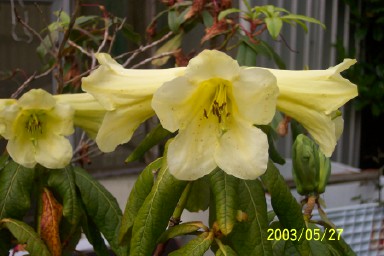
The years 1848-1850 will always stand out in the history of rhododendron cultivation as the beginning of the great era of Sino-Himalayan rhododendron discovery and introduction. Over that short period of time, Joseph D. Hooker, in his thorough exploration of Sikkim and the immediate surrounding areas, managed to introduce into cultivation nearly every rhododendron native to that region of the Himalaya. One of the most spectacular of his many outstanding introductions was Rhododendron dalhousiae Hook.f (1849) which was proclaimed by Hooker to be “the noblest species of the whole race.” Its amazing four-and-a-half-inch long creamy white to pale yellow flowers created quite a stir when it flowered for the first time in cultivation, a mere three years after seed was introduced by Hooker in 1950.
Since Hooker’s original introduction, R. dalhousiae (dal-house-e-e) has been collected many times throughout its extensive geographical range including the extreme southern border of Tibet, Bhutan, northeastern India (Sikkim & West Bengal), and Nepal. This species is native to the broad-leaved forest zone on the lower slopes of the eastern Himalaya from 5,000 to 9,000 feet in elevation. It typically grows epiphytically in large trees but is also found on cliffs, large boulders, and occasionally terrestrially on steep slopes. In Sikkim, I found it to be most common on steep cliffs and as an epiphyte in large trees of the oak and magnolia families (Fagaceae and Magnoliaceae respectively). I will never forget the magnificent floral display and sheer abundance of this species in a small area of southern Sikkim. The trees seemed to be literally dripping with blooming R. dalhousiae! The large clusters of pale creamy yellow trumpets were vividly highlighted against the dark green foliage of the trees in which they grew. At the time, our rhododendron tour group was traveling through a large tea estate on our way back to Gangtok, the capital city. The trees containing the epiphytic rhododendrons occurred as scattered specimens throughout the plantation and were probably remnants of the former native broad-leaved forest left standing to provide shade for the tea and its harvesters. Many of these large evergreen trees had three or four massive specimens of R. dalhousiae growing within their lofty boughs, providing one of the greatest spectacles in nature that I have ever witnessed.
A very closely related taxon, R. dalhousiae var. rhabdotum, was formerly considered to be a distinct species (R. rhabdotum), but was only distinguished from R. dalhousiae by the presence of red stripes on the corolla lobes. This former species was reduced to varietal status under R. dalhousiae by Dr. James Cullen in his 1978 revision of subgenus Rhododendron. It occurs in habitats and elevations similar to those of R. dalhousiae but is found only at the eastern end of the range of that species (northeastern India (Arunachal Pradesh), Bhutan, & southern Tibet). In October of 2003, I was a member of an expedition to this region and although we did not see it in flower, just seeing variety rhabdotum in its native habitat was one of the highlights of the trip. We always found this variety at around 8,600 feet where it grew with R. grande, R. griffithianum, and R. maddenii ssp. maddenii. The rhabdotum plants were growing in thickets on steep rocky slopes along the road where they could reach out to the sunlight. The large golden capsules were most impressive against the dark leaves and smooth cinnamon bark. Plants grown from seed collected in this region have since flowered, and I have been most impressed with the overall size and quality of the blossoms – much finer than any that I have previously seen in cultivation. Note: In the remaining text, my references to “this species,” “R. dalhousiae,” etc. should be interpreted as pertaining to both R. dalhousiae and its variety rhabdotum.
R. dalhousiae is a member of the Dalhousiae Alliance within subsection Maddenia. Other members of this Alliance include RR. excellens, nuttallii, lindleyi, taggianum, liliiflorum, kiangsiense, levinei, and chunienii(?). It is closely related to R. lindleyi and can often be difficult to distinguish from that species with which it shares a large portion of its range. However, R. lindleyi may be distinguished from R. dalhousiae by its highly fragrant, generally somewhat smaller white flowers and smaller, narrower leaves. Also, the calyx of R. lindleyi is distinctly fringed with long white hairs while that of R. dalhousiae is typically glabrous. In the wild, R. lindleyi generally occurs at slightly higher elevations where the ranges of the two species overlap.
As with most epiphytic rhododendrons, R. dalhousiae can be quite straggly and open in its growth habit, ranging from fully upright and shrub-like to procumbent and sprawling. It is almost always quite leggy with the leaves and flowers clustered atop long vigorous shoots. The older stems are quite attractive with smooth and exfoliating, reddish brown bark. The leaves are three to eight inches in length and up to three inches wide, narrowly elliptic to somewhat obovate in shape. The upper surface of the foliage is dark green and slightly bullate with deeply impressed veins. The lower surface has small, dark brown to reddish scales over a brownish to glaucous-green surface. The inflorescence consists of two to six flowers which are typically around four inches in length. They are tubular to funnel-campanulate in shape and range in color from white to cream or pale yellow, often flushed rose and usually with at least some fragrance. Populations of this species in northern Sikkim are described as being uniformly lemon-green in color and have been designated as ssp. tashii by Pradhan & Lachungpa in Sikkim-Himalayan Rhododendrons (1990). The flowers of var. rhabdotum are quite similar except for the five bright red stripes running the length of each corolla lobe. The flowers of both varieties typically emerge yellowish before aging to white or cream. In gardens, var. rhabdotum typically flowers later (mid- to late summer) than R. dalhousiae (late spring).
In cultivation, this free-flowering species is best grown in a cool greenhouse or comparably protected area in all but the mildest gardens. Most forms in cultivation are probably hardy to +10 or 15°F. with the flower buds probably a bit more tender than this. It does quite well planted out in very mild areas, such as coastal California, parts of Australia and New Zealand, and along the western coast of Scotland. Cultivation in areas with harsher conditions is usually limited to container culture. Of course, this species does not make the ideal container plant owing to its vigorous and leggy habit. It is, however, quite amenable to life in a pot if provided with a free-draining soil-less mix and the appropriate amounts of water and fertilizer to compensate for the restricted root system. As with all epiphytic plants, the growing media (for container or in-ground culture) must be exceptionally well-drained for successful cultivation. A coarse, chunky mix composed of organic material such as bark, compost, and/or coarse peat moss with pumice, grit or lava rock added for stability and structure makes an ideal “soil.” At the RSBG we grow our entire collection of R. dalhousiae in containers. Many of our large stock plants have been grown under these conditions for ten or more years and are still quite healthy and free blooming. The various members of this Alliance, including R. dalhousiae, are not particularly responsive to being cut or pinched back although selective tip-pinching of young shoots from an early age should result in a well-branched, more or less bushy specimen. I grow several specimens of both var. dalhousiae and var. rhabdotum in my own garden in West Seattle and have found that judicious pinching back for the first two or three years results in a well-branched small tree. These plants, once they have become “pot-bound” are actually quite tough and easy to maintain. Like most plants that are epiphytic in the wild, they are adapted to periods of drought and grow well with a small, somewhat restricted root system. In fact, plants grown with a restricted root zone in this fashion will bloom much sooner than those grown under more favorable conditions in the ground.
Despite its lack of hardiness, this species has remained quite popular – a testimony to the beauty and splendor of it floral display. It has been used to a small degree in hybridizing, with ‘Snow Mantle,’ ‘Alf Bramley,’ and ‘Countess of Haddington’ among its progeny. R. dalhousiae has received several awards, including the Award of Merit (AM) in 1930 when shown by Clyne Castle, Swansea, and again in 1974 for the clone ‘Tom Spring-Smythe’ shown by Sandling Park. This latter exhibitor also won the prestigious First Class Certificate (FCC) in that very same year with the clone ‘Frank Ludlow’ from Ludlow, Sherriff & Taylor #6694. The red-striped version of this species (R. dalhousiae var. rhabdotum) is also the bearer of awards, including the AM in 1931 to a clone shown by Bodnant and the FCC to clone shown by Exbury in 1934.
ACCESSIONS IN THE COLLECTION OF THE RSF:
R. dalhousiae var. dalhousiae
1977/605 Tatum. Typical yellowish cream fading to cream.
2000/025 Enjoy. I have not seen this clone in flower but it is labeled “best.”
2001/243 Schick. “A very compact and bushy form.”
Note: We also have over a dozen clones accessioned from seed collected in the wild from distinct or superior selected wild specimens under the numbers 130sd1995, SEH#502, SEH#521 & SEH#522. Although most of these have flowered over the past few years, they have not yet been fully evaluated.
R. dalhousiae var. rhabdotum
1977/703 Brodick. Flowers white with red stripes and a yellowish flush at the base of the tube.
1983/077 Schick. Similar to 1977/703 but with a larger and more greenish-yellow flush, red stripes.
1994/003 Enjoy. Cream flowers with red stripes.
2006/046, 2006/081 & 2006/116 All from KCSH#0310 – grown from seed collected in the wild.
Cullen, J. 1980. “A Revision of Rhododendron. I. Subgenus Rhododendron sections Rhododendron & Pogonanthum.” Notes from the RoyalBotanic GardenEdinburgh. Vol. 39(1).
Cox, Peter A. and Kenneth N.E. Cox. 1997. The Encyclopedia of Rhododendron Species. Perth, Scotland: Glendoick Press.
Davidian, H.H. 1982. The Rhododendron Species. Vol. I. Portland, OR: Timber Press.
Hootman, S.E. 1997 – 2003. Unpublished field notes.
Pradhan, U.C. & Lachungpa, S.T. 1990. Sikkim-Himalayan Rhododendrons. West Bengal, India: Primulaceae Books.
Rhododendron Species Foundation: Records – 1964 to present.
Steve Hootman
